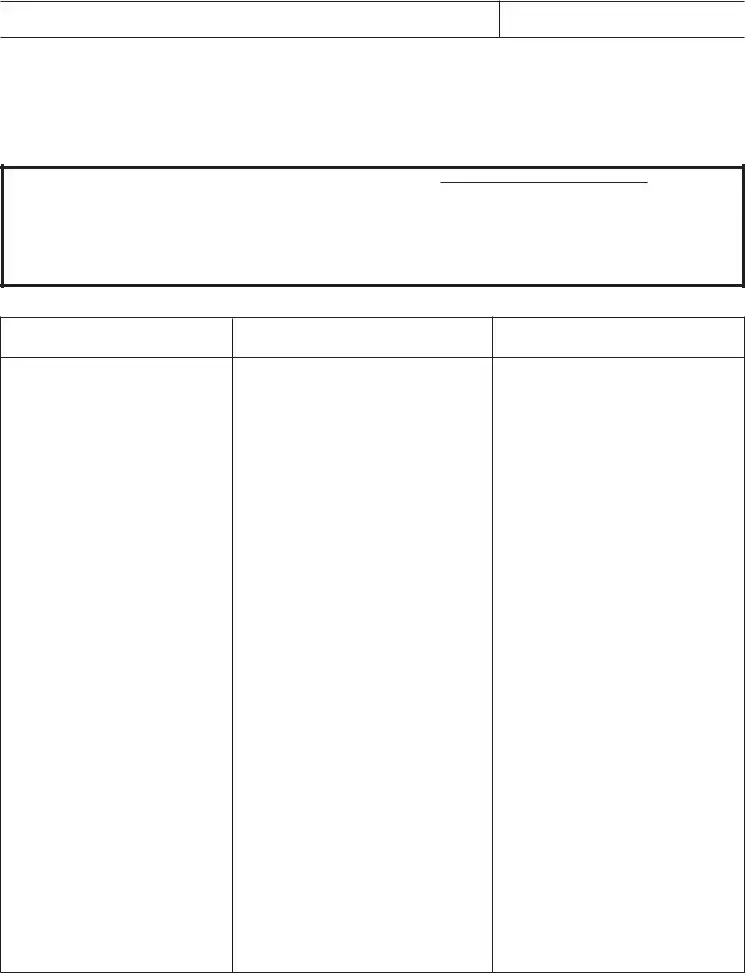IT-Estate 2017 |
STATE OF NEW JERSEY |
TrasferIheritaceTax |
Resident Decedent |
|
PO x |
ESTATE TAX RETURN 2017 |
TretN |
structisreverseside |
TISORTO USORTSWITTOTONORT |
UYTORUY |
(68) For Division Use Only
ecedet’sNa_______________________________________ |
___________________ecedet’sSSN______________ |
______________________ |
|
ast |
irst |
dde |
|
|
|
|
|
atefeathddyy_________________________u |
|
tyfResidece__________________ |
_____________ |
Testate |
Itestate |
MailingAddress |
Na_____________________________________________ |
aytiPhe |
_______________________________ |
|
to send all |
Street _______________________________________________________________________________________ |
correspondence* |
*SeeInstructions |
ity __________________________________________Stat e______________Zide__________________ |
|
|
|
|
|
|
|
|
|
|
|
|
|
|
|
|
|
|
ROSSTtertheTtagrssestatefrPartagei |
efthefederar |
|
UTIONSterdeductisfrPartageieft |
hefederar |
|
aTetativeTaxabeateSubtractiefrie |
a |
|
bStateeathTaxeductifrtherstateseistructi |
s |
b |
cTaxabeateSubtractiebfriea– terherea |
diNateTaxwebsitecacuatr |
|
TetativeNewrseyateTax– eterautcacuatedfrt |
heNateTaxwebsitecacuatr |
|
eNtetieiIstructis |
|
|
reditfrNewrseyIheritaceTaxPaidONOTINUIN |
TORPTY |
|
terthertifthetaxattributabetrertyca |
tedutsidefNewrseyfrief |
|
Schedueattached |
|
|
Ttaredits– diesadeterhere |
|
|
NetNewrseyateTaxue– ieusiefesst |
hazereterzer |
|
IterestadPeatyueeistructis |
|
|
Ttautue– diesad |
|
|
Paytutfay |
|
|
IfieisTiesubtractiefri |
eeterU– |
|
PYTISUNTWITOR |
|
|
IfieisRTiesubtractiefri |
e |
|
TRUNUNT |
|
|
You must include a completed Federal form 706 even if you are not required to file with the IRS. Include a complete, legible copy of decedent’s LastWill and Testament and all codicils thereto. Include a complete, legible copy of any trust agreements to whichthe decedent was a party.
**Allapplicationsfor therefundofan overpayment in additiontothe amountrequested online 13 ofthis return, must be madein writingwithinthe three-yearstatutoryperiod in accordancewith andinthe manner setforthinR.S. 54:38.3. (SeeInstructionsforfurtherinformation.)
fiatdecaresudereatyferjury |
|
|
|
|
|
Ihaveexaedthisreturadaaccayigdcutsadt |
|
thebestfwedgeadbeiefitistruecrrecta |
dceteIhereby |
authrizetheartysetfrthabvetactastheestate’srere |
setativetreceivecfidetiaifrtiadt |
resetatisbehafftheestate |
Subscribedadswrbefre |
|
|
|
|
|
this_____________dayf_________________________ |
_ |
Sigature |
_________________________________________ |
_________________ |
|
|
|
cutr– istratr– eirtaw |
|
|
|
PritNa |
___________________________________________ |
_______________ |
OfficiaTite _____________________________________ |
______ |
dress |
_________________________________________ |
_________________ |
|
|
|
__________________________________________________________ |
|
|
|
|
|
|
|
|
|
|
|
|
Estate Tax Return 2017 Instructions
Thisfristbeusedyfrtheestatefaresidetdece |
dethavigadatefdeathrafteruary |
butbefreuary |
__________________________________________________________________________________________ |
TheNateTaxisiadditittheNIheritaceTax |
taxisisedutheestatefeveryresidetdecedetha |
vigadatefdeathrafter |
uarybutbefreuarywhsetaxabee |
stateexceeds$iasdeteredursuattsecti |
ftheederaItera |
ReveuedeUSsieffectuary |
|
|
Filing Requirements |
|
|
rdecedetsdyigrafteruarybutbefre |
uaryaNewrseyestatetaxreturstbefiedif |
thedecedet’sgrssestate |
exceeds$iasdeterediaccrdacewiththervisi |
sftheIteraReveuedeieffectuary |
|
Completing the Return
Mailing Address – Complete the Mailing Address section with the name and address of the person or firm that will be authorized to receive all
communications from the Division of Taxation. NteTheivisiisrequiredtdeaywiththisers |
rfiruesstheestatereresetativehas |
|
ascetedr ittfTaxayerReresetative |
|
|
|
Complete Federal Form 706* icudigascheduesadsurtigdcutsThisstbe |
cetedeveifyuweretrequiredtfiewiththe |
|
federaIteraReveueServiceRSIfyuarerequiredtf |
ierdidfierwiththeIRSsubtacyfw |
hatwasactuayfied |
NOTE: Be |
sure to answer question 2(c) on Schedule M to avoid processing delays.
*Refers to the (Rev. August 2013) version of Form 706.
Complete lines 1 through 13 of the 2017 New Jersey Estate Tax Return. |
|
|
|
Instructions for Line 3b. State Death Tax Deduction for Other States: tertheautfayestateiheritaceegacyrsuccessi |
|
taxesactuay |
aidtaytherStateNOTicudeNewrseyrthei |
|
|
strictfuiaayrertyicudedithegrssestate |
|
|
iefthisretur |
Note to Line 4: Thewebsiteestatetaxcacuatricrratesacreditf$ |
whichisequatthetaxduethe$iexc |
|
usiautfr |
Itaserfrthecircuarcacuaticreatedbyaica |
|
|
tiftheNewrseyrtifthefederaStateeath |
|
|
Taxeductitthetaxabe |
estateiaccrdacewithSectiftheederaIte |
|
raReveuede |
|
|
|
Waiver Request Schedules: Complete Schedules E-4 thru E-7 trequestayecessarywaiversfrNewrseyassetsteThesched |
uesfthe |
aretsufficietfrwaiverurses |
Only list those assets which require waivers. See instructions on each schedule for guidance. |
Required Documents |
|
|
|
|
|
|
cyfaycicatifrtheIRSregardigtheateTa |
|
x |
|
|
|
ceteegibecyfthedecedet’sastWiad |
|
Testatadacdicistheret |
|
|
|
cyfaytrustagreetstwhichthedecedetwasaa |
rtyad |
|
|
|
cyfthedecedet’sastfuarfederaictaxretu |
|
rfiedrirtdeath |
|
|
|
Interest Rates and Payment Due Date |
|
|
|
|
|
|
IterestaccruesattherateferauayNateT |
|
|
axtaidwithiiethsfthedecedetsdatef |
|
deathIfaextesiftit |
fiethefederaestatetaxreturisgratedtheirectr |
|
yreduceiterestterauutitheearierfthee |
|
xiratifthefederaextesir |
thedatefthefiigfthefederareturwiththe |
IRS |
|
|
|
|
|
Requestsfraiterestreductistbeaccaiedbyacy |
|
|
ftherequestdettheIteraReveueServicefraexte |
|
sitfiethefedera |
estatetaxreturagwithacyfayrequiredarvaa |
|
|
dverificatiastthedatewhichthefederaestate |
|
taxreturwasactuayfied |
Paytsarefirstaiedttheiterestifaywhichhas |
|
accruedtthedatefayt |
|
|
|
Payments on Account / Refund Requests |
|
|
|
|
|
Paytsaccutybedeataytitavidfurtheraccrua |
|
|
fiteresttheautaidIaycasewherethea |
|
|
utaidaccut |
frNewrseyIheritaceratetaxesexceedstheautfta |
|
xdueafterthefiaassessthasbeedetheveraida |
|
utwiberefuded |
itheduecursefbusiess |
|
|
|
|
|
|
rtectiverefudcaishudbederITwithi |
|
|
threeyearsfrthedatefaytrtectiverefudcaii |
|
|
sacaifiedtrtect |
ataxayer’srighttatetiarefudbasedacti |
|
getevetfrwhichthestatutefitatisisabutt |
exire |
rtectivecaiisusuaybased |
ctigeciessuchasedigitigatiragig |
|
federaestatetaxaudit |
|
|
|
Lien |
|
|
|
|
|
|
rresidetdecedetsdyigaftereceertheN |
|
|
ateTaxreisaiearertyfthedecedetasf |
|
|
thedatefdeathutiaid |
Nrertyybetrasferredwithutthewrittecsetft |
|
|
heirectrftheivisifTaxati |
|
|
|
NEW JERSEY INHERITANCE AND ESTATE TAX:
RETURN PROCESSING INSTRUCTIONS
Follow these procedures to avoid delays in processing returns, waivers, and refunds:
DO NOT enclose returns in any kind of BINDER, SEALED FOLDER or
NOTEBOOK.
DO NOT use STAPLES (especially extra-long staples) on the return.
OIt is OK to use rubber bands or clips to keep the file together.
OTwo-hole ATCO fasteners, along the TOP of the return, are also acceptable.
DO NOT enclose DUPLICATE COPIES of returns or duplicates of other documents.
OWhen filing both Inheritance and Estate Tax, include only ONE copy of the will, trusts, income tax return, 706, appraisals, and any other attachments.
A few things to DO:
STAPLE checks to the completed payment voucher, and put voucher on
TOP.
OMake sure checks are signed, and made payable to “New Jersey Inheritance and Estate Tax”
OInclude the Decedent’s name and SS# on the check.
Place the return and schedules on top (if no payment), with the will and other supporting documents beneath.
Check that returns are SIGNED by the legal representative of the estate and NOTARIZED.
OThe representative’s name should be printed clearly beneath the signature
VERIFY the decedent’s social security number and date of death.
Make sure the MAILING ADDRESS on the return is correct – and indicates the person who you want to receive ALL correspondence (letters, bills, waivers, etc).
OThe Division cannot correspond with your attorney or CPA unless they are listed on the front page of the return.
Clearly mark amended returns as “Amended” along the
BOTTOM of the return.
File Inheritance Tax and Estate Tax returns together when
possible.
OKeep the two returns separate within the same envelope or box.
OKeep in mind the two taxes have separate due dates for payment of the tax.
OInclude separate checks and vouchers for each tax.
|
( |
T |
|
rnsernheritnx |
TT |
|
TTT |
|
x |
|
ttTxynt |
|
renton |
|
|
|
TTTT |
|
edentsme_______________________________________ |
_____________________________________________ |
|
(st |
(irst |
|
(ddle |
|
edentso_________________________________ |
|
_ |
|
|
|
teoeth(mmdd_________________________ou |
|
ntoResiden__________________ |
_______________ |
MailingAddress |
me_____________________________________imeone |
(_____________________ |
tosendall |
treet______________________________________________ |
_______________________________ |
correspondence |
|
it______________________________________ |
tte____ |
________ |
ipode________ |
|
|
|
|
|
|
|
TToTTin)
(ode |
tex(totloeremittedwiththisorm |
____________________________ |
ntsonuntmemdetntimetovoidurtherl orthereundonoverpntmustemdeinwritinwith themnnersetorthinR(texndR
ointerestonthemountsopidlpplitions inthethreersttutorperiodinrdnwithndin (nheritnx
kcckspyltonitncndttTx oxTnton
ncluddcdntsnndsocilscuitynuon cck)
remittinmorethnoneelisteeindividullelow
SCHEDULE E-4 stbecetedwithretur
WAIVER REQUEST SCHEDULE
NEW JERSEY REAL PROPERTY
Note: All items on this schedule must be reported on the Form 706
istaNSRPROPTYiwhichthedecedetheda |
|
iterest |
|
|
Rertfractiashares |
only iftherertywashedasteats |
|
|
|
trertrertyhedasteatsyhetiretyifsuseci |
viuiarterissurvivig |
|
Taxwaiverswitbeissuedfrassetstistedthissche |
due |
|
|
|
|
|
|
|
|
|
|
|
|
|
ecedet’sShare
uty
StreetadNuer
iciaity
t
c
TiteOwerfRecrd
ecedet’sShare
uty
StreetadNuer
iciaity
t
c
TiteOwerfRecrd
ecedet’sShare
uty
StreetadNuer
iciaity
t
c
TiteOwerfRecrd
fadditiasaceisrequiredattachridersfthesasize frybererduced
SCHEDULE E-5 stbecetedwithretur
WAIVER REQUEST SCHEDULE
NEW JERSEY BANK ACCOUNTS/CREDIT UNIONS/BROKERAGE ACCOUNTS
Note: All items on this schedule must be reported on the Form 706
|
|
|
|
|
|
|
|
istaassetshedi |
New Jersey bagistitutiswhichdecedet’saisisted |
|
|
hisyicudechecgaccutssavigsaccutseyrts’s |
|
adIR’s |
|
Icudetheafeachbaristitutiadaccut |
uertieaccutsi |
ebaybegruedtgetherbuteachaccutstbe |
istedsearatey |
Stateaas |
|
|
registeredeachaccut |
|
|
isty |
|
|
the full datefdeathbaacefeachaccutthisschedue |
|
|
Taxwaiverswitbeissuedfrassetstistedthissche |
due |
Brokerage Accounts must list total valueof account, rather than individual assets.
(C)
Full Date of Death Value
fadditiasaceisrequiredattachridersfthesasize frybererduced
SCHEDULE E-6 stbecetedwithretur
WAIVER REQUEST SCHEDULE
NEW JERSEY STOCK ONLY
Note: All items on this schedule must be reported on the Form 706
istONYstcicrrateditheStatefNewrseywhi chdecedet’saisisted
Rerttheuerfshareswedfeachstc
|
isttheafthecayadaas |
|
registeredeachstc |
|
Taxwaiverswitbeissuedfrassetstistedthissche |
due |
Stocks held in a Brokerage Account should notbe listed on this schedule – include them in Account Total on Schedule E-5.
fadditiasaceisrequiredattachridersfthesasize frybererduced







